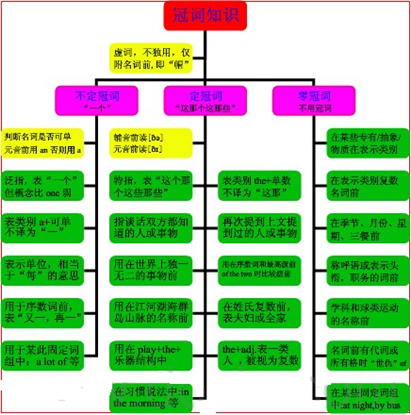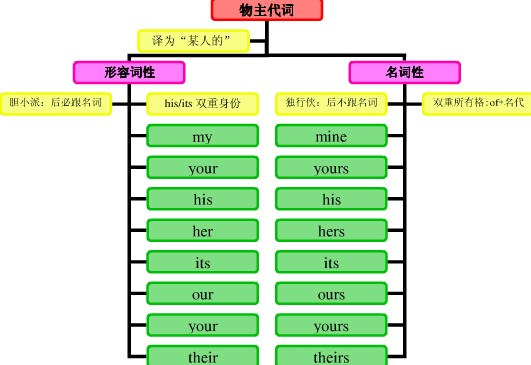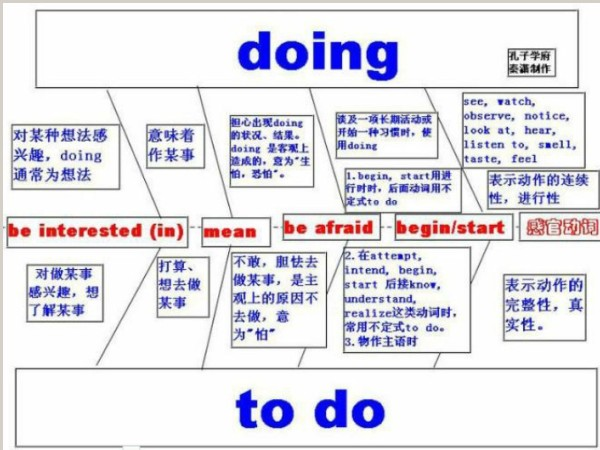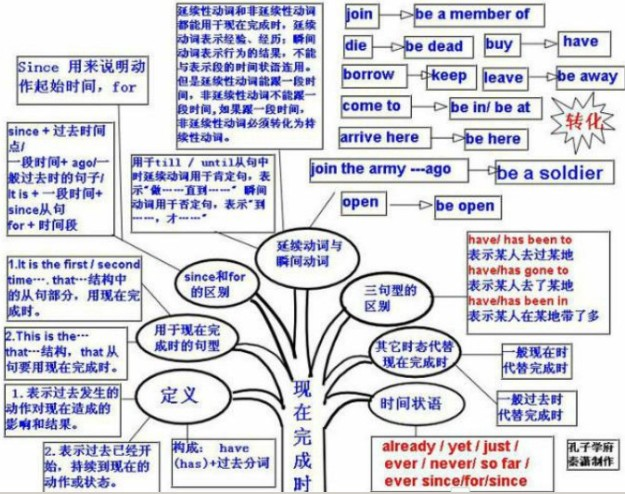本试题 “短文改错。 Last summer I learnt to ride a bicycle. At first,I was unable to control it's direction. SometimesI fall to the right or to the left. Bu...” 主要考查您对定冠词
物主代词
不定代词
副词
并列连词
动名词
一般过去时
现在完成时
等考点的理解。关于这些考点您可以点击下面的选项卡查看详细档案。
- 定冠词
- 物主代词
- 不定代词
- 副词
- 并列连词
- 动名词
- 一般过去时
- 现在完成时
定冠词的定义:
定冠词the 有this,that,these,those等意义,但较弱,用于单数或复数名词前,主要用来特指,使一个或几个事物区别于所有其他同名的事物。
定冠词通常位于名词或名词修饰语前,但放在both、all、double、half、twice等词之后。
如:All the students in the class went out.班里所有的学生都出去了。
定冠词的用法:
1、表示特指:
如:Look! A car has stopped there. The car is beautiful. 瞧,有辆汽车在那儿停下了。那辆汽车可真漂亮。
Why not ask the teacher? 为什么不问问老师?
2、与单数可数名词连用表类别:
如:I hate the telephone. 我讨厌电话。
The cobra is dangerous. 眼镜蛇是危险的。
3、与某些形容词连用表示类别:
如:The rich are not always happier than the poor. 富人并不总是比穷人过得开心。
Theoldaremorelikelytocatchcoldthantheyoung.老年人比年轻人容易感冒。
4、用于独一无二的事物名词前:
如:The earth goes around the sun. 地球绕着太阳转。
The sky was blue and clear. 天空清澈湛蓝。
5、用于方向或方位等名词前:
如:He looked towards the east. 他朝东望。
Turn to the right at the second crossing. 在第二十字路口向右拐。
6、用于序数词或形容词的最高级前:
如:You will be the second to speak. 你第二个发言。
Autumn is the best season here. 秋季是这里最好的季节。
7、用于乐器名词前表示演奏:
如:He plays the piano very well. 他的钢琴弹得很好。
注:若不是从演奏角度来考虑,而是考虑乐器的实体,则不一定用定冠词:
He bought a piano for his son. 他为儿子买了部钢琴。
定冠词与不定冠词互换用法比较:
1、在形容词最高级前一般加定冠词。但有时却用不定冠词,这时它不表示“最”的意思,而表示“非常”“很”的意思。
如:This is the most important question of all. 这是所有问题中最重要的一个。
This is a most important question. 这时一个非常重要的问题。
2、在序数词前加定冠词,表示“第几”;加不定冠词则表示“又”“再”。
如:Will you be the firse to read the text? 你第一个读课文好吗?
Will you have a second try? 你再试一次好吗?
3、在有些短语中,用定冠词和不定冠词一样。
如:The number of our school students is about 1500. 我校学生人数约为1500人。
定冠词的用法口诀:
特指双熟悉,上文已提及;
世上独无二,序数最高级;
某些专有名,习语及乐器。
以上口诀归纳了用定冠词的一般情况,即:
①特指某些人或物
②谈话双方都熟悉的人或事
③上文已经提到的人或事
④世界上独一无二的事物前
⑤序数词回形容词最高级前
⑥某些专有名词前
⑦一些习惯短语(如:intheday等)中和乐器前(如:playtheviolin/piano)。
定冠词知识体系:

定冠词用法拓展:
1、用于姓氏的复数前,表示全家人或全家中两个或两个以上的人:
如:The Browns live next to us. 布朗一家就住在我们隔壁。
The Greens have no Children. 格林夫妇没有小孩。
2、用来代替前面已提到的人的身体部位或衣着等的一部分:
如:He hit me in the face. 他打我的脸。
He caught the thief by the collar. 他抓住小偷的衣领。
3、用于逢整十数词的复数名词前,指世纪中的年代或人的约略年岁:
如:He began to learn French in his fifties. 他五十多岁开始学习法语。
He went to Japan with his family in the sixties. 他在60年代带家人去了日本。
4、用于某些单数可数名词前,使意义抽象化,指其属性或功能等:
如:This colour is pleasant to the eye. 这颜色悦目。
He is fond of the bottle. 他喜欢喝酒。
5、表示计算单位,含有a, each, per 之类的意义:
如:He is paid by the hour (piece). 他拿计时(件)工资。
It sells at two dollars the pound. 这东西每磅卖两美元。
6、用于人名前,或特指、或比喻、或指其作品等;用于某些产品的名称前,指产品:
如:He likes the Picasso. 他喜欢毕加索的画。
Lu Xun has been known as the Gorky of China. 鲁迅人称中国的高尔基。
7、用于江、(运)河、海、洋以及山脉、群岛、半岛、海岛、海峡、沙漠等名称的前:
如:the Chang jiang River 长江
the Pacific(Ocean) 太平洋
the Suez(Canal) 苏伊士运河
①关于湖名前是否用冠词通常要分两种情况:
中国的湖名在英译时,其前通常加定冠词:
the West Lake 西湖,the Dong ting Lake洞庭湖。
而外国的湖名前,多数不加定冠词,少数加定冠词,视习惯而定:
Lake Success 成功湖,the Lake of Geneva日内瓦湖
②山名的构成有两种方式:
若用于“山名+Mountains”,其前常用定冠词:the Jing gang Mountains 井冈山;
若用于“Mount/Mt+山名”,则通常不用冠词:Mount Tai 泰山。
另外,若不出现mountain一词时,则通常要用冠词:theAlps阿尔卑斯山。
8、用于由普通名词或含有普通名词构成的专有名词 (如国名、地名、政党、团体、组织机构以及旅馆、商店、学校、医院、文娱场所、建筑物等)前:
如:the United Nations 联合国
the People's Republic of China 中华人民共和国
the National People's Congress 全国人民代表大会
注:大学名称的构成要注意以下情况:
①对于以地名命名的大学,通常有两种形式 (注意冠词的有无):
如:the University of London / London University 伦敦大学
②对于以人名命名的大学,通常只有一种表达(不用冠词):
如:Yale University 耶鲁大学
Brown University 布朗大学
物主代词的概念:
表示所有关系的代词叫物主代词。
物主代词有两种形式:一种是形容词性物主代词,在句中只能充当定语;另一种是名词性物主代词,和名词用法相同,在句中作主语、宾语、表语等。
物主代词的特性:
1、物主代词既有表示所属的作用又有指代作用。
例如:John had cut his finger;约翰割破了手指。
物主代词有形容词性(my,your等)和名词性(mine,yours等)两种,形容词性的物主代词属于限定词。
名词性的物主代词在用法上相当于省略了中心名词的“'s”属格结构,
如:Jack's cap 意为 The cap is Jack's.
His cap 意为 The cap is his.
2、名词性物主代词的句法功能:
a.作主语,例如:May I use your pen? Yours works better.
b.作宾语,例如:I love my motherland as much as you love yours.
c.作介词宾语,例如:Your should interpret what I said in my sense of the word,not in yours.
d.作主语补语,例如:The life I have is yours. It's yours. It's yours. 我的生命属于你,属于你,属于你。
物主代词的基本形式:
|
第一人称 |
第二人称 |
第三人称 | ||||
|
|
|
名词性 |
形容词性 |
名词性 |
形容词性 |
名词性 |
|
单数 |
my |
mine |
your |
yours |
his |
his |
|
复数 |
our |
ours |
your |
yours |
theirs | |
形容词性物主代词的用法:
1、形容词性物主代词通常修饰名词,作定语。
如:We should treat her mother very well.
2、与own连用表示强调。
如:I saw it with my own eyes.
名词性物主代词的用法:
1、名词性物主代词可作主语、表语和宾语。
如:This is my desk. Yours is over there.
2、名词性物主代词常用于双重属格,于of连用。
如:This girl is a friend of mine.
物主代词知识体系:

物主代词特别用法:
1、名词性和形容词性物主代词不能混用。
如:Jack has a low opinion of Sue.
2、物主代词的单复数必须和它所指代的名词一致。
如:His idea is to do more practice every day.
3、对于anyone,anybody,everyone,everybody,应根据上下文来判断his或her,有时也可用their。
如:Has everyone finished their work?
不定代词概说:
英语的不定代词有all, each, both, either, neither, one, none, little, few, many, much, other, another, some, any, no, few, little, both, enough, every等,以及由some,any,no和every构成的合成代词(即somebody, anyone, nothing等)。在这些不定代词中,多数都能作主语、宾语、表语或定语,但是代词none以及由some, any, no和every构成的合成代词只能作主语、宾语或表语,不能作定语,而no和every则只用作定语。
不定代词用法对比:
1、so little与such little的区别:
用so little还是such little取决于little的意思:若表示数量方面的“少”,则用so little;若表示形状体积的“小”,则用such little:
如:He has so little time for reading. 他读书的时间少得可怜。
I've never seen such little boxes. 我从未见过那样小的盒子。
2、some与any的用法区别:
一般说来,some用于肯定句中,any用于否定句和疑问句中。但是,在表示请求、邀请或征求意见的句子中,通常要用some而不用any:
如:Would you like some cake? 吃点蛋糕吗?
Why not buy some bread? 为什么不买些面包呢?
Shall I get some chalk for you? 要我帮你拿些粉笔来吗?
注:any有时也用于肯定句中,此时表示“任何”:
如:Any colour will do. 任何颜色都行。
Come any day you like. 随便哪天来都可以。
3、many与much的用法区别:
两者都表示“许多”,但many修饰或代替可数名词(复数),与few(少数)相对;
而much用来修饰或代替不可数名词(单数),与little(少量)相对。在口语中两者主要用于非肯定句中:
如:Did you see many people there? 你在那儿看见许多人了吗?
We don't have much time. 我们没有许多时间。
在肯定句中,一般用a lot of, lots of, plenty of 等代之。但在正式文体中有时也用于肯定句中;
另外,若用作主语或主语的定语,或其前有how, too, as, so, a good, a great等修饰,也可用于肯定句中:
如:Many of us left early. 我们有许多人离开得很早。
Much work has been done. 许多工作都已经做了。
You've given me too much. 你已给我太多了。
Take as many(much) as you want. 你要多少拿多少。
I asked her a great many questions. 我问了她许多问题。
4、few, a few与little, a little的用法区别:
(1)few和a few后接可数名词的复数形式。few表示数量很少或几乎没有,强调“少”,含有否定意义;
a few表示数量虽然少但毕竟还有,强调“有”,含有肯定意义:
如:It is very difficult, and few people understand it. 它很难,没有几个人能懂。
It is very difficult, but a few people understand it. 他虽难,但是有些人懂。
(2)little和alittle之后接不可数名词,其区别跟few和a few之间的区别相似:
如:Unfortunately, I had little money on me. 很不巧,我身上没带什么钱。
Fortunately, I had a little money on me. 幸好我身上带着一点钱。
5、other, the other, another与others的用法区别:
这些不定代词不仅在含义上有单复数之分,而且在用法上有泛指(无the)和特指(有the)之别。其用法区别可归纳如下:
(1)指单数时,若泛指用another,若特指用the other:
如:Give me another(one). 另外给我一个。
Shut the other eye, please. 请把另一只眼睛也闭上。
(2)指复数时,若泛指用other(后接复数名词),若特指用the other(后接复数名词):
如:There are other ways of doing it. 做这事还有其他的办法。
Where have the other students gone? 其他学生都到哪里去了?
(3)others永远表示复数意义(且其后不能再接名词)。其用法大致相当于“other+复数名词”,同样地the others大致相当于“the other+复数名词”:
如:Other people[Others] may not think that way. 别的人可能不这样想。
He is cleverer than the others[the other students] in her class. 他比班上其他学生聪明。
(4)another一般只能表单数,且其后接名词也只能接单数名词。但是若其后有数词或few修饰时,则也可接复数名词:
如:We need another few chairs. 我们还需要几把椅子。
In another two weeks it'll be finished. 再过两个星期就可做完了。
(5)与some对比使用时,用others(此时与some同义):
如:Some say yes, and others say no. 有人说对,有人说不对。
不定代词用法点拨:
1、指两者和三者的不定代词:
有些不定代词用于指两者(如both, either, neither),有的不定代词用于指三者(如all, any, none, every),注意不要弄混:
如:Both of my parents are doctors. 我的父母都是医生。
All of the students are interested in it. 所有的学生对此都很感兴趣。
There are trees on any side of the square. 广场的每一边都种有树。
He has two sons, neither of whom is rich. 他有两个儿子,都不富有。
He has three sons, none of whom is rich. 他有三个儿子,都不富有。
注:each可用于两者、三者或三者以上,而every只用于三者或三者以上,因此用于两者时只能用each,不能用every。
2、复合不定代词的用法特点:
复合不定代词包括something, somebody, someone, anything, anybody, anyone, nothing, nobody, noone, everything, everybody, everyone等。它们在句中可用作主语、宾语或表语,但不能用作定语。something, someone等和anything, anyone等的区别与some和any的区别一样,前者一般用于肯定句,后者一般用于否定句、疑问句或条件句。具体使用时应注意以下几点:
(1)复合不定代词受定语修饰时,定语应放在它们后面:
如:There is nothing wrong with the radio. 这收音机没有毛病。
Have you seen anyone[anybody] famous? 你见过名人吗?
(2)指人的复合不定代词若用作主语,其谓语动词一般用单数,相应的人称代词和物主代词也用单数he, him, his(不一定指男性)。但在非正式文体中常用复数代词they, them, their:
如:Everyone knows this, doesn't he[don't they]? 人人都知道这一点,不是吗?
If anybody[anyone] comes, ask him[them] to wait. 要是有人来,让他等着。
(3)指事物的复合不定代词若用作主语,谓语动词只能用单数,相应的人称代词也只能用it,而不用they:
如:Everything is ready, isn't it? 一切都准备好了,是吗?
(4)anyone, everyone等只能指人,不能指物,且其后一般不接of 短语。若是指物或后接of 短语,可用any one, every one(分开写):
如:any one of the boys(books) 孩子们(书)当中的任何一个(本)
every one of the students(schools) 每一个学生(一所学校)
3、是any not还是not any:
按英语习惯,any以及含有any的复合不定代词用于否定句时,它只能出现在否定词之后,而不能在否定词之前:
误:Anyone doesn't know how to do it.
正:No one knows how to do it.任何人都不知道如何做它。
误:Anybody[Anyone] can not do it.
正:Nobody[Noone] can do it.这事谁也干不了。
误:Anything can not prevent me from going.
正:Nothing can prevent me from going. 什么也不能阻挡我去。
4、不定代词与部分否定:
不定代词all, both, every等与not连用时构成部分否定;若要表示完全否定,则需换用none, neither, no one等。
比较:All of the students like the novel. 所有这些学生都喜欢这本小说。
Not all of the students like the novel. 并不是所有这些学生都喜欢这本小说。
All of the students don't like the novel. 并不是所有这些学生都喜欢这本小说。
None of the students like the novel. 这些学生当中没有一个喜欢这本小说。
5、all, both, each等用作同位语:
若用作主语同位语,主语可以是名词或代词;若用作宾语等其他成分的同位语,则宾语等成分必须是人称代词,而不能是名词:
如:We have all read it. 我们都读过他。(all修饰的主语是代词)
The villages have all been destroyed. 村庄都被毁了。(all修饰的主语是名词)
They told us all to wait there. 他叫我们都在那儿等。(all修饰的宾语是代词)
但不能说:They told the men all to wait there. (all修饰的宾语是名词不是代词)
不定代词知识体系:

不定代词与语境考题:
不定代词是高考的常考考点,有的不定代词考题出得比较灵活,不能死套规则,要注意结合语境来理解:
例1:—Is____here?
—No, Bob and Tim have asked for leave.
A. anybody
B. everybody
C. somebody
D. nobody
解析:
若只是从表面来看,填空句是个疑问句,可能会误选A。但其实此题最佳答案应选B,因为下文的答句说“只有Bob和Tim请假了”,这说明问句是在查人数,故用Is everybody here? (大家都到齐了吗?)
例2:I agree with most of what you said, but I don't agree with_____.
A. everything
B. anything
C. something
D. nothing
解析:
此句若从表面看,有可能误选B,因为填空句为否定句。但实际上最佳答案为A,因为上文说“我同意他说的大部分内容”,这与下文的but I don't agree with everything (但并不是同意他说的所有内容)完全相符。
例3:—Doyouhave_____athomenow,Mary?
—No, we still have to get some fruit and tea.
A. something
B. anything
C. everything
D. nothing
解析:答案:C,句意为“玛丽,现在家里东西都准备齐了吗?”“还没有,我们还要买些水果和茶。”
例4:—If you want a necklace, I'll buy one for you at once.
—Oh, no. A necklace is not_____that I need most.
A. anything
B. something
C. nothing
D. everything
解析:
此题容易误选A,机械地认为:something用于肯定句,anything用于否定句或疑问句。但是,此题的最佳答案是B,something在此的意思不是“某种东西”,而是指“那种东西”或“这种东西”,即心中最想要的那种东西(相当于the thing)。
副词的概念:
副词是指在句子中表示行为或状态特征的词,用来修饰动词、形容词、其他副词、介词短语、非谓语动词乃至整个句子,表示时间、地点、程度、方式等概念。
副词的位置:
1)在动词之前。
2)在be动词、助动词之后。
3)多个助动词时,副词一般放在第一个助动词后。
注意:
a. 大多数方式副词位于句尾,但宾语过长,副词可以提前,以使句子平衡。
如:We could see very clearly a strange light ahead of us.
b. 方式副词well,badly糟、坏,hard等只放在句尾。
如:He speaks English well.
副词的排列顺序:
1)时间,地点副词,小单位的在前,大单位在后。
2)方式副词,短的在前,长的在后,并用and或but等连词连接。
如:Please write slowly and carefully.
3)多个不同副词排列:程度+地点+方式+时间副词。
注意:副词very可以修饰形容词,但不能修饰动词。
改错:(错)I very like English.
(对)I like English very much.
注意:副词enough要放在形容词的后面,形容词enough放在名词前后都可。
如:I don't know him well enough.
There is enough food for everyone to eat.
There is food enough for everyone to eat.
兼有两种形式的副词:
1)close与closely:
close意思是“近”;closely意思是“仔细地”。
如: He is sitting close to me.
Watch him closely.
2)late与lately:
late意思是"晚";lately意思是“最近” 。
如:You have come too late.
What have you been doing lately?
3)deep与deeply:
deep意思是“深”,表示空间深度;deeply时常表示感情上的深度,“深深地” 。
如:He pushed the stick deep into the mud.
Even father was deeply moved by the film.
4)high与highly:
high表示空间高度;highly表示程度,相当于much。
如:The plane was flying high.
I think highly of your opinion.
5)wide与widely:
wide表示空间宽度;widely意思是“广泛地”,“在许多地方”。
如:He opened the door wide.
English is widely used in the world.
6)free与freely:
free的意思是“免费”;freely的意思是“无限制地”。
如:You can eat free in my restaurant whenever you like.
You may speak freely, say what you like.
副词知识体系:

并列连词的概念:
连词是一种虚词,它不能独立担任句子成分而只起连接词与词,短语与短语以及句与句的作用。连词主要可分为两类:并列连词和从属连词。并列连词用来连接平行的词、词组和分句。如:and, but, or, nor, so, therefore, yet, however, for, hence, as well as, both...and, notonly...butalso, either...or, neither...nor, (and)then 等等。
并列连词与并列结构:
并列连词引导两个并列的句子。
1)and与or:
判断改错:
(错) They sat down and talk about something.
(错) They started to dance and sang.
(错) I saw two men sitting behind and whisper there.
(对) They sat down and talked about something.
(对) They started to dance and sing.
(对) I saw two men sitting behind and whispering there.
解析:第一句:and连接两个并列的谓语,所以talk应改为talked。
第二句:and连接两个并列的动词不定式,第二个不定式往往省略to,因此sang应改为sing。
第三句:and连接感观动词saw后面的用作的宾补的两个并列分词结构,因此whisper应改为whispering。
注意:and还可以和祈使句或名词词组连用表示条件。(or也有此用法)
如:Make up your mind, and you'll get the chance.=If you make up your mind, you'll get the chance.
One more effort, and you'll succeed.=If you make one more effort, you'll succeed.
2)both...and 两者都
如:She plays(both) the piano and the guitar.
3)not only...but(also), as well as 不但…而且
如:She plays not only the piano, but(also) the guitar.
注意:not only…but also关联两个分句时,一个分句因有否定词not而必须倒装。
如:Not only does he like reading stories, but also he can even write some.
4)neither...nor 意思为“既不……也不……”谓语动词采用就近原则,与nor后的词保持一致。
如:Neither you nor he is to blame.
比较so和such :
so与such的用法由不同词性决定。such是形容词,修饰名词或名词词组,so是副词,只能修饰形容词或副词。so还可与表示数量的形容词many,few,much,little连用,形成固定搭配。
构成:so+adj.
such+a(n)+n.
so+adj.+a(n)+n.
such+n.(pl.)
so+adj.+n.(pl.)
such+n.(pl.)
so+adj.+n.[不可数]
such+n.[不可数]
如:so foolish
such a fool
so nice a flower
such a nice flower
so many/few flowers
such nice flowers
so much/ little money.
such rapid progress
so many people
such a lot of people
注:so many 已成固定搭配,a lot of 虽相当于many,但a lot of为名词性的,只能用such搭配。 so...that与such...that之间的转换既为so与such之间的转换。
并列连词用法点拨:
1、表示并列关系:
1)or意思为“否则”。
如:I must work hard, or I'll fail in the exam.
2)either...or意思为“或者……或者……”。注意谓语动词采用就近原则。
如:Either you or I am right.
2、表示转折或对比关系:
1)but表示转折,while表示对比。
如:Some people love cats, while others hate them.
典型例题:
—Would you like to come to dinner tonight?
—I'd like to, ___ I'm too busy.
A. and
B. so
C. as
D. but
答案:D。but与前面形成转折,符合语意。而表并列的and,结果的so,原因的as都不符合句意。
2)not...but...意思为“不是……而是……” not和but后面的用词要遵循一致原则。
如:They were not the bones of an animal, but(the bones) of a human being.
3、表示原因关系:
1)for 判断改错:
(错)For he is ill, he is absent today.
(对)He is absent today, for he is ill. for是并列连词,不能置于含两个并列分句的句子的句首,只能将其放在两个分句中间。
并列连词知识体系:
| 种类 | 用法 | 举例 |
| 并列连词 | 表示转折关系 | yet, but等 |
| 表示并列关系 | and, or, either...or..., as welll as等 | |
| 表示因果关系 | for, so等 |
比较and和or的用法:
1)并列结构中,or通常用于否定句,and用于肯定句。
2)但有时and也可用于否定句。请注意其不同特点:
如:There is no air or water in the moon.
There is no air and no water on the moon.
在否定中并列结构用or连接,但含有两个否定词的句子实际被看作是肯定结构,因此要用and。
典型例题:
—I don't like chicken___fish.
—I don't like chicken, ___I like fish very much.
A. and;and
B. and;but
C. or;but
D. or;and
答案:C。否定句中表并列用or,but表转折。
判断改错:
(错)We will die without air and water.
(错)We can't live without air or water.
(对)We will die without air or water.
(对)We can't live without air and water.
动名词概念:
动名词是一种兼有动词和名词特征的非限定动词。它可以支配宾语,也能被副词修饰,动名词有时态和语态的变化。
现在分词和动名词用法比较:
动词的-ing形式包括现在分词和动名词两种形式。他们的句法功能如下:
动词的-ing形式如果作句子的主语或者宾语时,应该是动名词形式;如果作补语或者状语时,应该是现在分词形式。那么作表语或者定语的动名词和现在分词又该怎样区分呢?
1、动名词与现在分词作表语时的比较:
(1)动名词作表语说明主语的内容,回答what的问题;现在分词作表语相当于形容词作表语,说明主语的性质、特征等,回答how的问题。
如:One of the best exercises is swimming. 游泳是最好的运动项目之一。
What pleases him most is bathing in the sea. 最使他高兴的事是在海中沐浴。
The situation both at home and abroad is very in-spiring. 国内外的形势都很鼓舞人心。
The color is pleasing to the eye. 颜色悦目。
(2)动名词作表语,表语和主语几乎处于同等地位,可以互换位置,其句意不变;现在分词作表语,表语和主语则不能互换位置。
如:Our work is serving the people.
(=Serving the people is our work.)我们的工作是为人民服务。
The news was disappointing. 那消息令人失望。
(3)作表语的现在分词前可以用very,quite,rather,greatly等副词修饰,而动名词则不可以。
如:What he said was very encouraging. 他的话很鼓舞人心。
Our goal is realizing the four modernizations in the near future. 我们的目标是在不久的将来实现四个现代化。
(4)现在分词与形容词一样可以和more,the most构成形容词的比较级和最高级,而动名词则不可以。
如:The story is the most fascinating. 那个故事最迷人。
(5)作表语用的现在分词除了和be连用以外,还可以和其它的系动词连用;而作表语的动名词则通常只能和be连用。
如:His speech seems inspiring.他的演讲似乎很鼓舞人心。
His interest is writing for the news papers. 他的爱好是给报社写文章。
(6)有些用作表语的现在分词已经形容词化了。常见的有:exciting,moving,inspiring,missing,interesting,disappointing等。
2、动名词与现在分词作定语时的比较:
(1)动名词作定语时,表示它所修饰的名词的性能和用途,和它所修饰的名词在逻辑上没有主谓关系;
现在分词作定语时,表示它所修饰的名词正在进行的动作,和它所修饰的名词在逻辑上有主谓关系,常可以扩展成一个定语从句。
如:a swimming girl=a girl who is swimming 一个在游泳的姑娘
a walking stick=a stick that is used for walking 一根拐杖
(2)现在分词作定语有时可以后置,而动名词则通常只能放在它所修饰的名词之前。
如:The girl wearing glasses is one of his students. 戴眼镜的那个女孩是他的一个学生。
I bought some reading materials. 我买了一些阅读材料。
动名词的用法:
1、作主语:
例如:Fighting broke out between the South and the North. 南方与北方开战了。
2、作宾语:
a. 有些动词可以用动名词作宾语。
例如:admit承认 appreciate感激 avoid避免 complete完成 consider认为 delay耽误 deny否认 detest讨厌 endure忍受 enjoy喜欢 escape逃脱 fancy想象 finish完成 imagine想象 mind介意 miss想念 postpone推迟 practice训练 recall回忆 resent讨厌 resume继续 resist抵抗 risk冒险 suggest建议 face面对 include包括 stand忍受 understand理解 forgive宽恕 keep继续
例如:Would you mind turning down your radio a little, please? 你把收音机音量调小一点,好吗?
The squirrel was lucky that it just missed being caught. 这松鼠幸运得很,刚逃避了被逮住的厄运。
b. 有些结构后面可以用动名词作宾语或其他成分。
例如:admit to prefer...to burst out keep on insist on count on set about put off be good at take up give up be successful in be used to lead to devote oneself to object to stick to no good no use be fond of look forward to be proud of be busy can't help be tired of be capable of be afraid of think of
3、作表语,对主语说明、解释:
例如:Her job is washing, cleaning and taking care of the children. 她的工作是洗刷、清扫和照顾孩子。
比较:She is washing, cleaning and taking care of the children.
4、作定语,一般表示所修饰名词事物的用途:
例如:a writing desk=a desk for writing 写字台
a swimming pool=a pool swimming 游泳池
有些动名词作定语,与所修饰的名词关系比较复杂。
例如:boiling point=a temperature point at which something begins to boil 沸点
a walking tractor=a tractor which a driver can operate while he or she is walking behind it 手扶拖拉机
动名词知识体系:

动名词与不定式用法对比:

一般过去时的概念:
一般过去时表示过去某个时间里发生的动作或状态;过去习惯性、经常性的动作、行为;过去主语所具备的能力和性格。
一般过去时的用法:
1、表示过去发生的动作或存在的状态,常与表示过去时间的副词如:yesterday,last week,two hours ago等连用。
如:My family moved here five years ago. 我家五年前搬到了这里。
I was born in 1973. 我生于1973年。
2、表示过去一段时间经常或反复发生的动作。这时可与频度副词如:often,usually,always等连用。
如:He always worked in tonight those days. 那些日子他总是工作到深夜。
I often left on business in 1987. 1987年我经常出差。
注:表示“过去经常,而今不再”时,要用usedto.
如:I used to read newspaper after breakfast. 我过去经常早饭后看报纸。(意指现在已不是这样)
The children often swam in this river. 孩子们过去经常在这条河里游泳。
3、表示过去发生的一连串动作。
如:He put down the heavy box, took out the keys, and opened the door. 他放下这沉重的箱子,掏出钥匙开了房门。
注:过去发生的一连串动作,若用and,or,but等并列连词连接,则一律用过去式。
如:They moved the chairs to the table, sat down and began to have supper. 他们把椅子搬到桌边,坐下开始吃饭。
4、在时间和条件状语从句中,用一般过去时表示过去将来的动作。
如:He said that he would let me know as soon as he got the information. 他说他一得到消息就立即让我知道。
Mary told me that she would stay at home if it rained. 玛丽告诉我如果下雨她就呆在家里。
一般过去时的特别用法:
1、句型:It is time for sb. to do sth "到……时间了" "该……了"。
例如:It is time for you to go to bed.你该睡觉了。
It is time that sb.did sth. "时间已迟了" "早该……了"。
例如:It is time you went to bed. 你早该睡觉了。
2、would(had)rather sb.did sth. 表示'宁愿某人做某事'。
例如:I'd rather you came tomorrow. 还是明天来吧。
3、wish, wonder, think, hope等用过去时,作试探性的询问、请求、建议等,而一般过去时表示的动作或状态都已成为过去,现已不复存在。
例如:I thought you might have some. 我以为你想要一些。
比较:Christine was an invalid all her life.(含义:她已不在人间。)
Christine has been an invalid all her life.(含义:她现在还活着)
Mrs. Darby lived in Kentucky for seven years.(含义:达比太太已不再住在肯塔基州。)
Mrs. Darby has lived in Kentucky for seven years.(含义:现在还住在肯塔基州,有可能指刚离去)
注意:用过去时表示现在,表示委婉语气。
1)动词want, hope, wonder, think, intend等。
例如:Did you want any thing else? 您还要些什么吗?
I wondered if you could help me. 能不能帮我一下。
2)情态动词could, would。
例如:Could you lend me your bike? 你的自行车,能借用一些吗?
现在完成时的概念:
现在完成时用来表示之前已发生或完成的动作或状态,其结果的影响现在还存在;也可表示持续到现在的动作或状态。其构成:have(has)+过去分词。
现在完成时共有四种主要用法:
一、现在完成时表示影响:
该用法的现在完成时表示一个过去发生的动作在过去已经完成,并且这个过去发生并完成的动作对现在有影响或结果,同时说话者强调的或感兴趣的就是这个影响或结果,如汉语说“他已离开这个城市了”,其中的“离开”肯定发生了,它对现在的影响或结果就是“他现在已不在这个城市了”;又如汉语说“有人把窗户打破了”,显然“打破窗户”这一动作发生在过去,并且在过去已经完成了,但说话人强调的重点是打破窗户对现在的影响—窗户现在仍是破的。
如:He has left the city. 他已离开这个城市。(结果:他不在这个城市。)
Someone has broken the window. 有人把窗户打破了。(结果:窗户仍破着。)
I have lost my pen. 我把钢笔丢了。(结果:我现在无钢笔用。)
He has finished his work. 他把工作做完了。(结果:他现在可以做其他的事了。)
二、现在完成时表示持续:
该用法的现在完成时表示一个过去发生的动作或开始的状语在过去并未完成或结束,而是一直持续到现在,并且有可能继续下去(也可能到此结束),如汉语说“他在我们学校教书已有30年了”,显然“他在我们学校教书”是从30年前开始,并且一直教到现在,已经持续了30年;又如汉语说“自上个星期以来他一直很忙”,显然“忙”是从上个星期开始的,并且这一“忙”就一直忙到现在。
如:He has taught in our school for 30years. 他在我们学校教书已有30年了。
He has been busy since last week. 自上个星期以来他一直很忙。
He has worked for us ever since he left school. 他离开学校以后就一直为我们工作。
三、现在完成时表示重复:
即表示从过去某个时间直到现在的这个时间范围内不断重复发生的动作或情况,并且这个不断重复的动作有可能继续下去,也有可能到现在就结束。
如:How often have you seen her? 你隔多少见她一次?
My father has always gone to work by bike. 我父亲一向骑车上班。
四、现在完成时表示将来:
同一般现在时可以表示将来一样,现在完成时也可以在时间状语从句里表示将来。
如:I'll wait until he has written his letter. 我愿等到他把信写完。
When you have rested, I'll show you the garden. 等你休息好之后,我领你看我们的花园。
现在完成时知识体系:

比较一般过去时与现在完成时:
1)一般过去时表示过去某时发生的动作或单纯叙述过去的事情,强调动作;现在完成时为过去发生的,强调过去的事情对现在的影响,强调的是影响。
2)一般过去时常与具体的时间状语连用,而现在完成时通常与模糊的时间状语连用,或无时间状语。一般过去时的时间状语:yesterday, last week,…ago, in1980, in October, just now等,皆为具体的时间状语。现在完成时的时间状语:for, since, sofar, ever, never, just, yet, till/until, up to now, in past years,always等,皆不确定的时间状语。共同的时间状语:this morning, tonight, this April, now, already, recently, lately等。
3)现在完成时可表示持续到现在的动作或状态,动词一般是延续性的,如live, teach, learn, work, study, know。一般过去时常用的非持续性动词有come, go, leave, start, die, finish, become, get married等。
例如:I saw this film yesterday.(强调看的动作发生过了)
I have seen this film.(强调对现在的影响,电影的内容已经知道了)
Why did you get up so early?(强调起床的动作已发生过了)
Who hasn't handed in his paper?(强调有卷子未交,疑为不公平竞争)
He has been in the League for three years.(在团内的状态可延续)
He has been a League member for three years.(是团员的状态可持续)
句子中如有过去时的时间副词(如yesterday, last, week, in1960)时,不能使用现在完成时,要用过去时。
(错)Tom has written a letter to his parents last night.
(对)Tom wrote a letter to his parents last night.
与“短文改错。 Last summer I learnt to ride a bicycle. At fir...”考查相似的试题有:
- helicopter can take off and land straight up or down, and can also staystill in air.A.The; anB.A; theC.A; 不填D.T...
- In the year 2010 Yushu earthquake struck on April 14, 2010,_____ came as ___great shock toall of our Chinese.A.That...
- In many places in China, _____ bicycle is still _____ poplar means of transportation.[ ]A. a; theB. /; aC. the; aD. t...
- Mary sees the bar as a starting point and______ plans to run her own chain of country inns.[ ]A. trulyB. automaticall...
- At school, some students are active____ some are shy, yet they can be good friends with one another.A.althoughB.whi...
- I thought we’d be late for the concert, _____we ended up getting there ahead of time.A.butB.orC.soD.for
- Only after he took off his sunglasses ______ him as one of my favourite movie stars.A.I recognizedB.I didn’t recogn...
- They only hear while their hands and eyes are_________ occupied.A other than B. no other than C. otherwise D. other ways
- 单词拼写。根据下列句子及所给汉语注释,在横线上写出空缺处各单词的正确形式。(每空只写一词)1. The postman will ______(...
- 短文改错。Yesterday a school boy is daydreaming in class.Not knowing that he was doing,he put a pencap into his mouth...